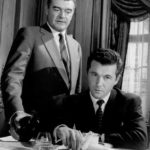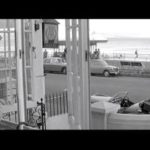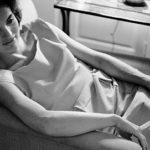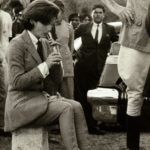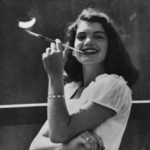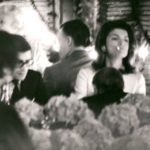Still rather blocked, though I’m determined to get the review of the Miller book on R. Welch drafted before I knock off. It is just after midnight, and I have plenty of tea. Tetley tea, in the round sachets.
I slept like a log from about 5pm to 8. Before that, I’d been out on this rainy day to see a curated talk at the new Grey Museum (formerly Grey Art Gallery) south of Cooper Square. I had no idea where to find it, expecting it to be near the big block sculpture or Cooper Union. No, it’s way down past the old NYHRC (now LIFE TIME Fitness; not much activity within, it looks like), and past the Muji store to the south of that. I was lucky to see the new navy-and-white banner waving up on high. 18 Cooper Square, easily a quarter mile south of Astor Place.
I was much too early for the tour (1 pm) so I killed time in Muji. Did not need to buy anything, but I’ll pick up a couple of black t-shirts there soon.
It was drizzling. I didn’t know it was going to rain, didn’t bring my umbrella. The enormously stout assistant at reception had me marked down for the 12 tour, which is not what I registered for. Fortunately I had the receipt e-mail. She was very nice about it. Most of the turnout were old folks, the sort of people who like this sort of thing. The them was “Americans in Paris,” post-WWII. Mostly people you’ve never heard of. A few Negroes, a few Jews. Early abstract expressionism, geometric designs, complex armatures of black welded metal.
Pleasant layout in the new address, though the old one, on Washington Square, had the advantage of location, as well as seeming like one great big room that didn’t need to be partitioned off.
Thought I’d grab a bite to eat afterwards. Maybe the Japanese BBQ place I’d passed on my way. Going out into the rain, I saw Phebe’s way down on whatever street this Cooper Square branches off into. Bowery? Bowery68 is the wifi pw. Sat at bar, ordered a Blue Moon beer and a Blackjack burger, which is an $18 cheeseburger with jack cheese and bacon. Cooked medium, and absolutely delicious. A dark, somewhat bearded Irish fellow named Ciaran at the bar. Exchanged a few words in Erse with someone who came in. I told him and a young woman at the bar that when I first visited Phebe’s it was much smaller and John and Yoko were there. Years later I used to accompany a friend who owned a club on the other side of town (Glenn) and would check out CBGB and other clubs to see what was coming up.
At home all I wanted was to lie down and go to sleep, though I fooled a bit with email and the London Review of Books before passing out.
A week ago Rob D. died. He and I were interacting via the new Substack fiction sites we started, coincidentally around the same time. I guess his “Sebastian” story will never have an ending. Rob was a bit better with fiction than nonfiction, where he tells everything in a droning, sonorous manner and is very lazy about visuals and specifics. It’s like Norman Mailer criticizing Morley Callaghan’s memoir in the NYRB 60 years ago, telling how the memorist doesn’t bother to make his own material interesting and seductive, or even informative. (Comparison to someone who met Truman Capote, and upon being questioned, says, “Oh he’s very bright and he’s short.”)
This vacuousness comes up in his two self-published memoirs, one about the “Troupe,” the other about going to a rehab clinic about 12 years ago. In the first he’s describing the branding and collateral we used on our flyers and posters. Originally the mascot of the C-heads was an old line-drawing clip art of a fellow who was supposed to be Bob Dobbs, of the Church of the Subgenius. Doug K. pasted a serrated crown onto his head and renamed him News King. News King had his own life before the C-heads, in some zine Doug or a friend put out. And now Doug repurposed him for C-head programs.
But Rob’s description of it all is that there was a generic line-drawing of a stereotypical Dad figure that we used as symbol of the C-heads. Did he really not know the background here, or did he just not want to go into tiresome details?

Much more annoying and inattentive is how he describes the usual C-head branding, once we moved on from News King. This started as a tiny halftoned image of the smiling head of Fatty Arbuckle. Bob Keenan, a graphics whiz, blew this up many times so the halftone dots were big and clear. As Rob describes it, this was some line art of a fat man that Bob came across, and it rather resembled Bob, which is why, perhaps, it was chosen.
We had this branding worked into all of our posters, etc., for years. I recently saw a pic of Rob wearing one of these shirts. Funny that he didn’t make the Fatty Arbuckle connection.

Rob in C-head shirt
Or perhaps…perhaps…he knew it all once, but just plumb forgot. His “Troupe” book, a memoir of the C-heads, focuses mainly on stressful adventures that he went through as a writer and sometimes crew member.
My theory about Rob’s prose style was that he was trying to perfect a kind of flat, affectless prose, where colorful details were neglected on purpose, out of a kind of “whatever!” contempt for too many descriptives. Somewhat like Hemingway, but not a Hemingway parody. Something like O’Hara, but without pages of ear-catching dialogue. In fact, Rob’s really bad at dialogue altogether, like J. Boylan. Everybody ends up talking in the same cadence and idiom. I don’t think he got much helpful criticism from that writers group he went to in Hamilton, Massachusetts.
From the time he moved to Hamilton, he informed me that it was the hometown of General George S. Patton. This surprised me, because when I was at the Santa Anita racetrack and Huntington Library with Ted O’Keefe and Bill and Karen Hulsy, Ted pointed out that this is where Patton grew up. (San Gabriel, CA, actually.) It seems Patton married a wealthy heiress from the Boston area, and that’s how he came to claim Hamilton, MA as home. For me this is a very telling detail, and Rob was getting it all wrong. It wasn’t quite Patton’s hometown. Hamilton may be duly proud of the Patton connection, but George didn’t move there until he was out of West Point. It happens that I have a book on the Patton family.

Both the Rob memoirs I mention begin with thanks and acknowledgments to such friends from the circle, beginning with the name of Amy Bishop, and that is an eye-catcher. Amy was the biologist who shot up her Huntsville, AL fellow faculty members in early 2010. I was sitting in the breakfast lounge of a snazzy boutique hotel* in Boston that weekend, in town for some races at the Harvard indoor track, when I tuned into Facebook, and there was Rob, telling us all about how he’d known Amy for years. She was crazy, most certainly, but Rob never said so, or gave any indication he thought so.
Now Amy’s long in prison, and Rob is gone. I should drop Amy a note.
*Charlesmark, I see in an old diary. On Boylston St near Copley Square.

